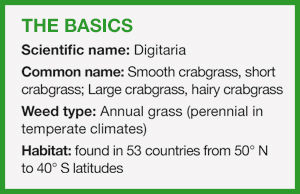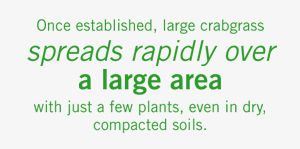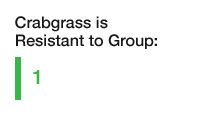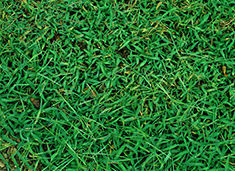Stamping Out Seeds Key to Managing Crabgrass
May 22, 2018

Introduced to the United States in 1849 as a forage crop, crabgrass now plagues crop fields, lawns and golf courses across the country. In most parts of the country, crabgrass is an annual weed, but in temperate climates, it can grow like a perennial. Unlike most grasses with tall growth habits, crabgrass is low-growing, creating a weed mat that hugs the soil surface.

Damage and Economic Impact

Both large crabgrass and smooth crabgrass can create significant problems if left untreated.
- Prolific seed production makes crabgrass a powerful contender for critical crop resources.
- Once established, large crabgrass spreads rapidly over a large area with just a few plants, even in dry, compacted soils.
- Crabgrass can serve as a bridge between rotated crops for viruses such as tobacco mosaic, barley stripe mosaic, panicum mosaic, sugar cane mosaic and wheat streak mosaic. Control of crabgrass is therefore an important disease management tool.
Massive Seed Production

Crabgrass can reproduce two ways: through tillers or seeds. A crabgrass plant can produce as many as 150,000 seeds and as many as 700 tillers.1 Two to three seed crops can be produced in a single growing season if the top growth is mowed off.
Crabgrass begins to germinate when soil temperatures hit 50-55°F for three days in a row, typically in early to mid-March. In southern states, germination can occur even earlier. Plant growth is slow in the spring but will take off in June or early July, slowing again as it enters its reproductive flowering stage in late July and early August.
Large and smooth crabgrass seeds are dormant just after being shed, but warm temperatures and sunlight bring seeds out of dormancy. Crabgrass seeds can also remain viable in the soil for many years.
Identifying Crabgrass
The two primary species of crabgrass – large and smooth– are similar, but they have a few specific identifying characteristics.
Large crabgrass:
- Seedlings have a green leaf sheath with purple shading and stiff hairs.
- The first leaf has a white stripe through the middle, light purple coloring and silky hairs.
- Large crabgrass has short straplike projections with no auricles (earlike projections) at the base of the leaf, then turn smooth and flattens at the peak and roots at the nodes.
- Four to six branches sport 2- to 8-inch long leaves, which turn dark red with age.
Smooth crabgrass:
- Smooth crabgrass looks like large crabgrass, but it does not have hair on the stems or sheaths and does not root at the nodes. It is also low- growing but not quite as coarse or tall as large crabgrass.
- Mature leaves are generally shorter, averaging 2 to 6 inches.
- The base of the plant tends to have a reddish or purplish tint.
- Often confused with broadleaf signal grass or Texas panicum, smooth crabgrass lacks the hairy ligule of both.
Known Resistance to Crabgrass

Crabgrass has shown resistance to ACCase herbicides (1) in the northern and eastern United States.2 Crabgrass problems have increased with a reliance on ALS herbicides (2), according to university research.3 While smooth crabgrass is tolerant to ALS herbicides, in large crabgrass, ALS herbicide control or suppression will be determined by plant height, with smaller plants being more susceptible to a post-emergent ALS herbicide.
How Do I Manage Crabgrass?
Because of seed proliferation, crabgrass usually requires several seasons to achieve control. The following are some strategies for managing crabgrass:
- The key is to control seed reinfestation. If the seed supply is successfully diminished, crabgrass will no longer be a significant threat; however, this requires a strict adherence to a weed management program.
- Start with a pre-emergence grass herbicide, an essential tool to eliminate crabgrass pressure.
- While crabgrass seeds germinate early, they often emerge later after other weeds have already been controlled, making the use of a post- emergence herbicide difficult but not impossible.
- Scout and consider clean cultivation to control escapes. Scout for late escapes and be prepared to make a late post-herbicide application if needed.
- Rotating to a small grain crop can also assist with serious infestations because crabgrass does not compete well in crops that develop an early canopy.
Bayer Solutions for Managing Crabgrass

Bayer has a broad portfolio to combat tough-to-control and resistant weeds. Remember: Not every product is suitable for every situation, and use of the correct application technique will ensure the best results.
Recommended Two-Pass Program for Crabgrass in Corn
Use Corvus® (2, 27) to start clean. This pre-emergence residual herbicide from Bayer has overlapping sites of action to control early-season problem weeds. Corvus is the only corn herbicide to offer burndown, residual and reactivation. Residual activity prevents new weeds, while the unique power to reactivate controls late weeds.
Another pre-emergent herbicide Bayer offers corn growers is Balance® Flexx (27), a cost effective, flexible foundation to any herbicide program. Balance Flexx provides long-lasting residual control, is easily tankmixed with other herbicides, and can be applied in all soil types.
If weeds re-emerge, a timely post-emergence herbicide application is needed. DiFlexx® DUO (4, 27) offers fast, effective control of late-season weeds, with an application window up to V10. DiFlexx DUO also has built-in resistance management with two powerful and effective sites of action to take down tough-to-control weeds.
To learn more about products Bayer offers to help control weeds as part of an integrated weed management program, contact your local Bayer sales representative.
Before applying any herbicide, please read the entire label for the best possible results and to confirm that the product is effective on the weeds you wish to control. Corvus and Balance Flexx are restricted use pesticides.
Sources:
1. "Crabgrass." http://wssa.net/wp-content/themes/WSSA/WorldOfWeeds/crabgrass.html
2. Kendig, Andrew. "Herbicide Resistance in Weeds." May 2006. http://extension.missouri.edu/p/G4907
3. Trower, Tim and Boerboom, Chris. "Large & Smooth Crabgrass." Nov. 2002. https://fyi.uwex.edu/weedsci/2002/11/12/large-smooth-crabgrass/